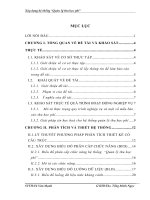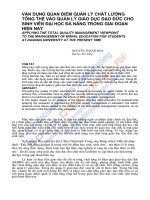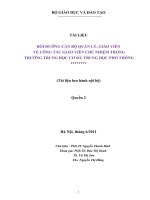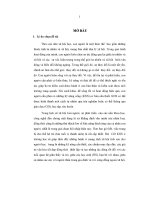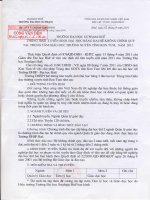- Trang chủ >>
- Lớp 11 >>
- Giáo dục công dân
Lecture Web technologies and programming – Lecture 2: The web application development process - Web project management - TRƯỜNG CÁN BỘ QUẢN LÝ GIÁO DỤC THÀNH PHỐ HỒ CHÍ MINH
Bạn đang xem bản rút gọn của tài liệu. Xem và tải ngay bản đầy đủ của tài liệu tại đây (341.03 KB, 20 trang )
<span class='text_page_counter'>(1)</span><div class='page_container' data-page=1></div>
<span class='text_page_counter'>(2)</span><div class='page_container' data-page=2></div>
<span class='text_page_counter'>(3)</span><div class='page_container' data-page=3>
3
</div>
<span class='text_page_counter'>(4)</span><div class='page_container' data-page=4>
•
<b>Web engineering extends Software </b>
<b>Engineering to Web applications</b>
•
<b>Why web engineering?</b>
•
<b>Web applications</b>
•
<b>Categories of web applications</b>
•
<b>Characteristics of web applications</b>
</div>
<span class='text_page_counter'>(5)</span><div class='page_container' data-page=5>
5
•
<b>Development Process model</b>
– <b>software development process activities</b>
•
<b>Requirement for a web development </b>
<b>process model</b>
•
<b>Rational unified process model (RUP)</b>
– A modern process model derived from the
work on the UML and associated process.
</div>
<span class='text_page_counter'>(6)</span><div class='page_container' data-page=6>
6
•
<b>A </b>
<b>set</b>
<b> of related activities that leads to </b>
<b>the </b>
<b>production</b>
<b> of a software product</b>
– <b>development of software from scratch</b>
– <b>extending and modifying existing systems</b>
•
<b>Common activities</b>
– <b>Software specification</b>
– <b>Designing and implementation</b>
– <b>System validation</b>
</div>
<span class='text_page_counter'>(7)</span><div class='page_container' data-page=7>
7
•
<b>Software specification: </b>
•
<b>The </b>
<b>functionality </b>
<b>of the software and </b>
<b>constraints</b>
<b> on its operation must be </b>
<b>defined</b>
– <b>critical stage (can lead to problems in </b>
<b>design and implementation)</b>
•
<b>Activities:</b>
– <b>Feasibility study</b>
– <b>Requirement elicitation and analysis</b>
– <b>Requirement specification</b>
</div>
<span class='text_page_counter'>(8)</span><div class='page_container' data-page=8>
8
•
<b>Software design and implementation: </b>
•
<b>Design is the </b>
<b>description</b>
<b> of</b>
– <b>System structure</b>
– <b>Data models</b>
– <b>Interface between components</b>
•
<b>Implementation: </b>
<b>Converting</b>
<b> a system </b>
</div>
<span class='text_page_counter'>(9)</span><div class='page_container' data-page=9>
9
•
<b>System validation: </b>
•
<b>Intended to show</b>
<b> that the system </b>
– <b> confirms its specification</b>
– <b>meets customer’s expectations</b>
•
<b>Development testing</b>
– <b>tested by the people developed the </b>
<b>components</b>
•
<b>System testing</b>
– <b>finding component integration errors</b>
•
<b>Acceptance testing</b>
– <b>System is tested by the customer’s</b>
</div>
<span class='text_page_counter'>(10)</span><div class='page_container' data-page=10>
10
•
<b>Software evolution:</b>
•
<b>Software is</b>
<b> flexible </b>
<b>as compared to </b>
<b>hardware </b>
– <b>Changes can be made to the system </b>
</div>
<span class='text_page_counter'>(11)</span><div class='page_container' data-page=11>
11
•
<b>The waterfall approach </b>
•
<b>(</b>
complete each process step before beginningthe next)
•
<b>Iterative approach</b>
• <b>(</b>Go quickly through all process steps to create a
rough system, then repeat them to improve the
system)
•
<b>Reuse oriented approach </b>
•
<b>(</b>
systems are integrated from existing</div>
<span class='text_page_counter'>(12)</span><div class='page_container' data-page=12>
•
<b>Evolving</b>
<b> from informational medium to </b>
<b>application medium</b>
•
<b>Existing approaches are </b>
<b></b>
<b>over-pragmatic</b>
– <b>lead to short development time</b>
•
<b>Web engineering </b>
<b>does not have its own </b>
<b>mature</b>
<b> development process model</b>
•
<b>SE development process models are </b>
</div>
<span class='text_page_counter'>(13)</span><div class='page_container' data-page=13>
13
•
<b>Handling Short development cycles</b>
– <b>Development time is short</b>
• <b>Normally does not exceed six month</b>
– <b>Immediate delivery mechanism</b>
• <b>Capture share in the market</b>
– <b>Leaves less freedom for systematic </b>
</div>
<span class='text_page_counter'>(14)</span><div class='page_container' data-page=14>
14
•
<b>Handling changing requirement</b>
– <b>Requirements often emerge during </b>
<b>development</b>
• <b>as developer understand the unknown business</b>
– <b>Integrate changes rapidly to remain in </b>
<b>competition</b>
– <b>User involvement is more critical</b>
</div>
<span class='text_page_counter'>(15)</span><div class='page_container' data-page=15>
15
•
<b>Releases with fixed deadlines and </b>
<b>flexible contents</b>
– <b>Due to rapid changes in requirements, </b>
<b>disposable releases are required</b>
• <b>To detail and validate customer’s requirements</b>
– <b>Release intervals are very short</b>
• <b>Time plan for releases is more important than </b>
</div>
<span class='text_page_counter'>(16)</span><div class='page_container' data-page=16>
16
•
<b>Parallel development of different </b>
<b>releases</b>
– <b>To meet time constraints, parallel and </b>
<b>overlapping development is required</b>
– <b>Several small teams work on similar tasks</b>
– <b>Communication overhead is extensive in </b>
</div>
<span class='text_page_counter'>(17)</span><div class='page_container' data-page=17>
17
•
<b>Reuse and integration</b>
– <b>to meet time constraints developer try to </b>
<b>reuse components</b>
• <b>Leads to integration issues</b>
– <b>Development can not be isolated from the </b>
</div>
<span class='text_page_counter'>(18)</span><div class='page_container' data-page=18>
18
•
<b>Adapting to web application’s </b>
<b>complexity level</b>
– <b>process depends upon the level of </b>
<b>complexity</b>
– <b>process is adapted dynamically</b>
• <b>for low complexity, it should be like lightweight </b>
<b>process</b>
• <b>for high complexity, it should be like </b>
</div>
<span class='text_page_counter'>(19)</span><div class='page_container' data-page=19>
•
<b>RUP is a </b>
<b>heavyweight</b>
<b>, </b>
<b>phase oriented</b>
<b>, </b>
<b>incremental</b>
<b> and </b>
<b>iterative</b>
<b> process</b>
•
<b>Described in three perspectives</b>
– <b>Dynamic perspective: phases over time</b>
– <b>Static perspective: activities in process</b>
– <b>Practice perspective: good engineering practices</b>
</div>
<span class='text_page_counter'>(20)</span><div class='page_container' data-page=20>
20
•
<b>RUP phases:</b>
•
<b>Inception</b>
– Establish the business case for the system.
•
<b>Elaboration</b>
– Develop an understanding of the problem
domain and the system architecture.
•
<b>Construction</b>
– System design, programming and testing.
•
<b>Transition</b>
– Deploy the system in its operating
</div>
<!--links-->

